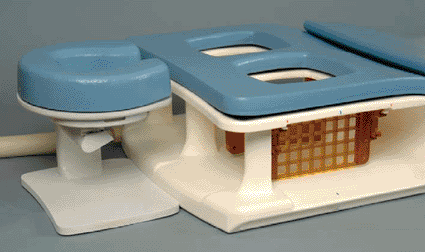Breast Coil Designed for MRI with Diagnostic and Interventional Capabilities
By MedImaging staff writers
Posted on 10 Jan 2008
Posted on 10 Jan 2008

Image: The Access Breast Coil for high quality diagnostic imaging, flexibility in interventional access and increased patient comfort (Photo courtesy of Confirma)
Confirma (Bellevue, WA, USA), a developer of application-specific computer-assisted detection (CAD) systems for MRI, recently presented its Access Breast Coil at the Radiological Society of North America (RSNA) annual meeting in Chicago, IL, USA, November 25-30, 2007.
"The Access Breast Coil offers imaging centers and their patients advanced diagnostic and interventional capabilities with exceptional ergonomics,” said Wayne Wager, president and CEO of Confirma. "The Access Breast Coil and CADstream will further improve confidence in breast MRI by providing the tools necessary to build premium, comprehensive breast MRI programs.”
The Access Breast Coil's four-channel, phased-array coil architecture provides high-quality parallel imaging of the breast, chest wall, and axillary tissue. Access is optimized for parallel imaging and supports both bilateral and unilateral imaging. Initially, the Access Breast Coil is compatible with Siemens Medical Systems' (Erlangen, Germany) Avanto and Espree 1.5T MRI scanners. The Access Breast Coil has received U.S. Food and Drug Administration (FDA) clearance and Siemens certification.
The open design of the breast coil allows for flexibility in performing interventional procedures from both lateral and medial approaches. Interventional components consist of a reusable interventional grid and stabilization plate, and are compatible with all major vacuum-assisted biopsy systems. Confirma received U.S. Food and Drug Administration (FDA) 510(k) clearance on the Access Breast Coil's interventional components July 2007, and anticipates market release early in the first quarter of 2008.
The design also focuses on ergonomics, allowing for enhanced patient comfort during both diagnostic and interventional exams. Positioning accessories, including a headrest and chest and torso pads, relieve pressure on the sternum and provide customized patient positioning during diagnostic and interventional breast MRI studies and procedures.
Interventional features include: an open coil design for easy lateral and medial interventional access; interventional components support a wide range of needle gauge sizes and vacuum-assisted biopsy systems; and integrated interventional components aid breast stabilization and needle positioning.
Ergonomic features include: design maximized patient comfort; accessories, including adjustable headrest and torso pads for flexible, customized patient positioning; cushioned adjustable headrest with mirror; and large apertures to accommodate a large portion of the patient population.
Due to the recent news and published clinical studies supporting breast MRI for increased breast cancer detection, it is becoming increasingly important to improve the analysis of these complex and time-consuming studies. CADstream is an intuitive technology that is advancing breast MRI by enhancing quality, standardization, and the efficiency of studies. CADstream is designed for any workflow situation, integrating with existing equipment and providing access to studies, anywhere on the network.
Related Links:
Confirma














